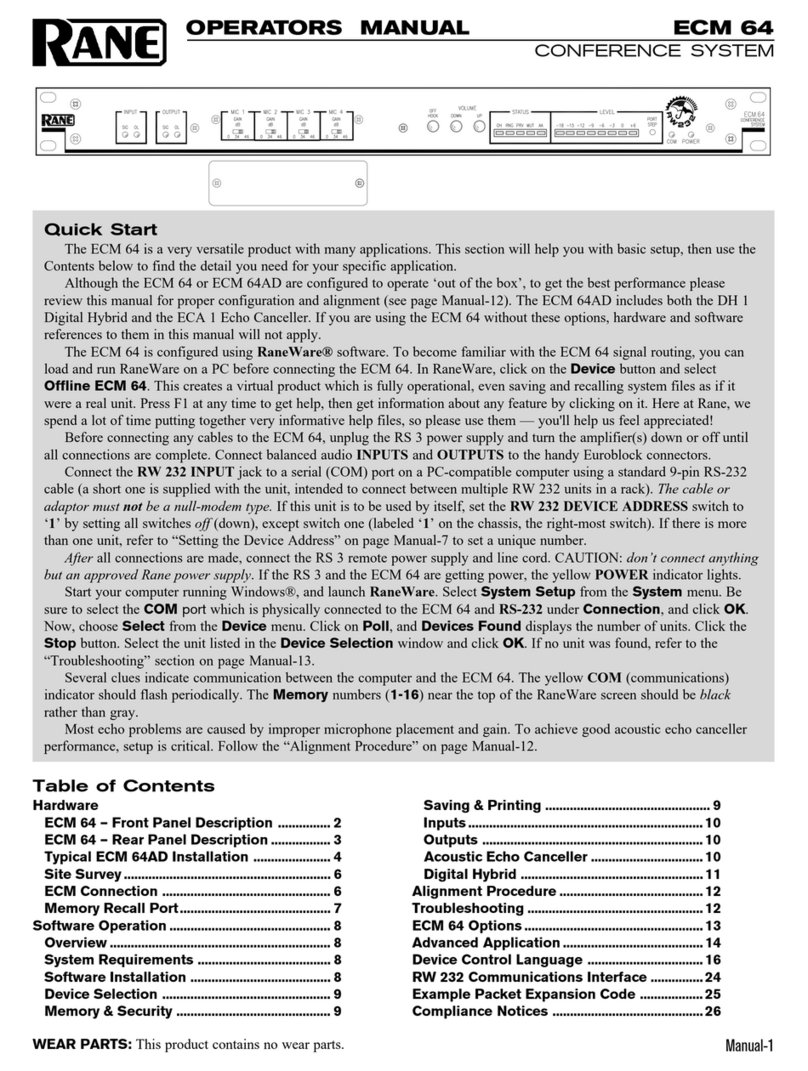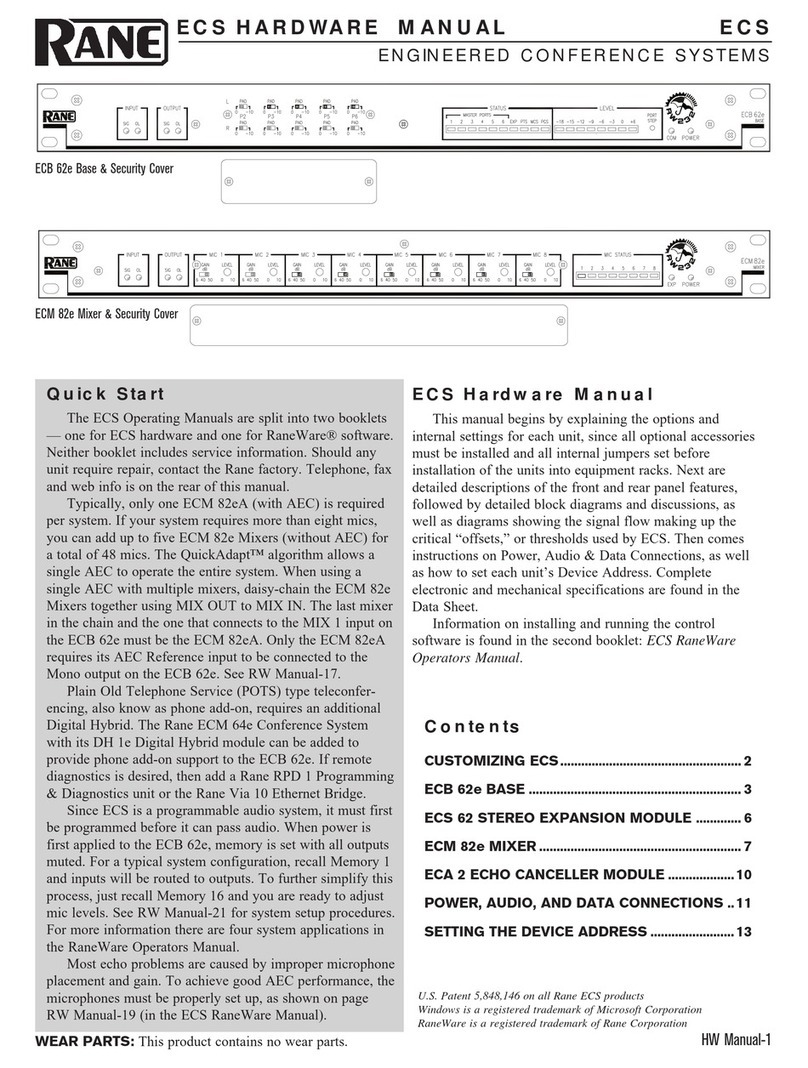
Manual-9
PHANTOM POWER
The ECM 8 Mixers are shipped with internal Phantom
Power switches in the “on” position. To change, remove the
top cover and look for the switches in the middle left of the
circuit board, as shown on page Manual-13.
REDUCING NOISE AND ACOUSTIC GAIN
Three methods are available to reduce noise and acoustic
gain due to the mixing of multiple microphones and multiple
echo cancellers.
The first method is a special NOMM Mode (Number of
Mics & Mixers open). This function maintains full level at the
Master Mic Input that has detected audio, while reducing
Gains of the other Inputs in order to maintain unity gain.
The second method is a Mixer Gate. This function reduces
the Output Level of the Mixers that are not detecting audio and
do not have a current Master Mic. When using the ECM 8
Expansion Input, deselect the Mixer Gate.
The third method, Mixer Suppression, utilizes a one shot
suppression technique. This is only active when a new Input
has Gated-On and audio is no longer detected at the previous
Input. The added Suppression is 12 dB. Activating Mixer
Suppression allows the Echo Canceller to readapt to the new
Mic without returning echo.
An example of Mixer Suppression:
1. Someone talks at local Mic 1. (New Input = false)
2. The person at local Mic 1 stops talking and someone at the
remote location talks. (No Mixer Suppression is added.)
3. Someone at local Mic 2 starts to talk. (New Input = true)
4. The person at local Mic 2 stops talking and someone at the
remote location talks. (Mixer Suppression is added.)
5. Someone at local Mic 2 starts to talk again. (New Input =
false) (No Mixer Suppression is added.)
DEVICE ADDRESS
The Mixer’s rear panel ECS INTERFACE DEVICE
ADDRESS determines its Mixer number and Mic Input
numbers. For example, Device Address 1 is Mixer 1 including
Mics 1-8, and Device Address 2 is Mixer 2 including Mics 9-
16. Only Device Addresses 1 through 6 are allowed, since this
is the maximum Mixers per Base. When a Mixer is first
powered up and has not received data from the Base, the Mic
Status LEDs display the Mixer Device Address.
An invalid Device Address set on the Mixer causes its
COM LED to continually flash. The ECM 8’s power must be
cycled after changing the Device Address. Unplug from the
wall, not the unit!
TERMINATION
If four or more Mixers are used with a Base, set the
termination switch up on the last Mixer (only).
EE
EE
ECC
CC
CM 8 MM 8 M
M 8 MM 8 M
M 8 MIXIX
IXIX
IXEE
EE
ERR
RR
R
The ECM 8 Mixer is a digitally-controlled-analog eight
channel Mic/Line auto-mixer. An optional internal DSP Echo
Canceller module is available either separately (model ECA 1)
or included (model ECM 8A). Each Base supports up to 6
Mixers, allowing 48 Inputs. All system parameters of the Base
and Mixers are stored within the Base using non-volatile
memory (no batteries). The ECM 8 Mixer is not a stand-alone
device and will not operate without a Base connected.
All functionality is controlled through RaneWare. Software
controls are printed in san-serif type like this. See the
RaneWare Operators Manual for complete details.
LAST-ON or GATED MODES
Unlike other auto mixers, the ECM 8 allows each Mic
Input to be either Last On or Gated. A Mic assigned as
Gated simply turns the Input on when the input signal is
above the Threshold Level, and turns the Input off when the
signal drops below and the Release Timer has expired. A Mic
assigned as Last On remains on once it becomes the Master.
A Master Mic is a status signal generated when audio is
detected at a Mic Input for a period of time longer than the
Master Mic Delay timer setting. If an Input is assigned as
Last On, and audio is detected for a period longer than the
Master Mic Delay timer, that Input becomes the Master and
remains on until a new Input takes over. The old Master Mic
then releases and returns to its set Gate Depth.
MIC THRESHOLD
Each Mic channel can operate in either an Automatic or
Manual Threshold mode. In Automatic Threshold mode,
Mic 1 of each Mixer is used to calculate the background room
noise level. This calculated level replaces the set Threshold
Level for this Mic channel.
MZEC™ (em-zeck)
Using large auto mixers with an echo canceller can cause
echo problems when several microphones gate-on at the same
time. If a single echo canceller is adapting to all Mic signals,
and more than three Mics are on at the same time, the acoustic
model for the room may become too complex. This causes
Echo Canceller divergence, resulting in more suppression or
return echo. To eliminate this problem, each ECM 8 Mixer
allows the addition of an internal Echo Canceller. Placing an
Echo Canceller in each mixer reduces the number of acoustical
echo paths for a multi-microphone system, improving the
system audio quality. (See the ECA 1 Echo Canceller module
on page Manual-13.) This method is called MultiZone Echo
Cancelling (MZEC™).
For multiple Echo Cancellers to properly adapt to the
room, each Mixer must have at least one Mic set to Last On
and the Mixer Gate must be checked. This allows each Mixer
to keep a Mic open for the Echo Canceller to adapt. Port 1’s
MONO Output from the Base must be connected to all of the
E/C REF Inputs of the Mixers.






























